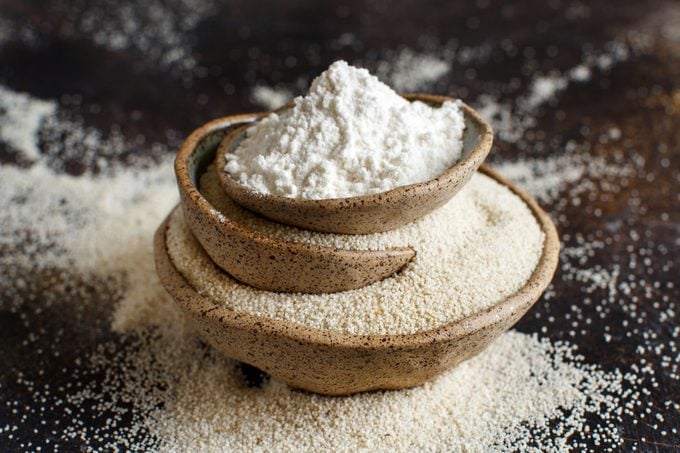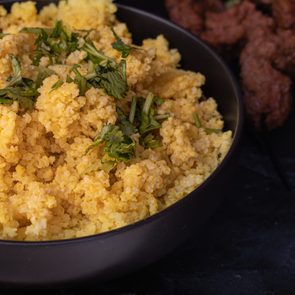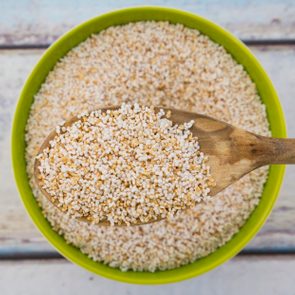The Ancient Grain You Need in Your Diet: Fonio
Updated: Jun. 29, 2021
Fonio is a small seed that's classified as an ancient whole grain and packed with nutrients. Check out the health benefits and some tasty recipes to try.
What is fonio?
If you’ve never heard of fonio, a tiny seed often referred to as an ancient grain, you’re not alone. Amid the soaring popularity of ancient grains like quinoa, millet, and amaranth, fonio has mostly flown under the radar. But that’s starting to change. The seed is now available in U.S. grocery stores and even stars in some new snack foods.
Fonio is a type of millet. That term may sound familiar: millet is often added to birdseed. But the seeds aren’t just for the birds. Fonio has a delicious nutty flavor and is packed with nutrition.
“Fonio is a nutrient-dense whole grain that’s rich in fiber and plant-based protein,” says Beth Stark, a registered dietitian nutritionist in Harrisburg, Pennslyvania. “It also supplies B vitamins, zinc, iron, and magnesium and is naturally gluten free and vegan, making it a nutritious choice for individuals that follow such dietary patterns.”
Origins of fonio
It may be new to you, but fonio is considered one of the oldest cultivated grains. West Africans have grown it for thousands of years. Today, it remains an important crop in countries like Nigeria, Togo, and Benin.
This tiny seed is a member of the Poaceae grass family. These kinds of grasses are able to grow and thrive in challenging climates and terrains, making them important crops for people who live in regions with extreme temperatures.
Some varieties of fonio grow much faster than other cereals, providing a harvest within six to eight weeks of planting. In fact, it’s considered one of the fastest-growing cereals. This helps minimize hunger by increasing access to food when other crops aren’t readily available.
Fonio nutrition facts
This tiny seed packs a rich nutrient punch with plenty of fiber, vitamins, minerals, and two important amino acids. “Fonio is also a source of B vitamins, zinc, and magnesium,” says Danielle Gaffen, a registered dietitian nutritionist in San Diego.
B vitamins, like B6 and B12, benefit the metabolism and aid in cell regeneration, a natural process that replaces damaged or missing cells, says Rachel Naar, a registered dietitian in New York City.
Here’s what is in a quarter cup (45 grams) of dry fonio, which yields about a half cup cooked:
Calories: 170
Total Fat: 0.5 g (1 percent recommended daily value, or DV)
Cholesterol: 0 g
Protein: 2 g (4 percent DV)
Carbohydrate: 39 g (14 percent DV)
Fiber: 1 g (4 percent DV)
Sodium: 0 g
Iron: 0.72 g (4 percent DV)
Varieties
There are two varieties, or species, of fonio. White fonio (Digitaria exilis) is the most widespread and the type you’re most likely to find in stores. It’s also known as Acha, especially in Nigeria.
Black fonio (Digitaria iburua), often called Iburu, isn’t widely cultivated. It’s typically grown in certain areas of Nigeria, as well as in the countries of Togo and Benin.

Health benefits of fonio
Adding this seed to your diet could offer health benefits—though because it has been under the radar, there have been few scientific studies comparing it to other cereal grains.
There is still much to uncover about this seed, but what we do know is promising. “The benefits associated with eating an adequate amount of whole grains and fiber from foods like fonio and others may include weight management, blood sugar control, lower cholesterol, appetite control, and a healthier [gastrointestinal] GI tract, or gut,” says Stark.
It’s a source of two amino acids
Amino acids are the building blocks of protein and play a lot of important roles in your body. “Amino acids are important for skin, muscle, hair growth, and protein synthesis,” says Naar. While your body can make some amino acids (we call those nonessential), it relies on food for others, known as essential amino acids.
“What sets fonio apart from most other grains is that it contains significant amounts of cysteine and methionine, two amino acids that are important in human growth,” says Gaffen. “These two amino acids are often lower in other cereal grains.”
There are 20 different types of amino acids, and each one serves specific functions. “Methionine is an essential amino acid that helps with skin, hair, and nail growth,” says Naar. “Cysteine is a nonessential amino acid that helps with protein synthesis and detoxification.”
This amino acid profile gives fonio a leg up when comes to deciding which grain to eat with dinner. “Even though it has about the same amount of protein as you would find in something like white rice, it has a more complex amino acid profile than typical grains like corn, wheat, and rice,” says Naar.
And fonio’s amino acid content is a boon for people who follow a vegetarian, vegan, or plant-based diet. “In my experience in counseling, people who subscribe to vegan or vegetarian [diets] are often lacking enough of the essential amino acids,” she says.
It helps control blood sugar
Foods that we eat take different amounts of time to be digested depending on the amount (and types) of carbs, fats, and protein they contain. “The glycemic index is a system of assigning a number to a carbohydrate-containing food according to how [quickly] the food increases blood sugar,” says Gaffen. “The glycemic index is a tool to help guide food choices.”
Foods that have a low glycemic index take more time to digest, which reduces and often prevents rapid increases in blood sugar levels. “Fonio has a low glycemic index, meaning it takes longer for the body to absorb and doesn’t quickly raise blood sugar levels, “says Naar. That makes it a good grain option for people with diabetes.
Another advantage to fonio is that it contains resistant starch—a kind of carbohydrate that skips digestion in the small intestine. Instead, it goes right to the large intestine.
Why is that a good thing? Carbs are broken down into glucose (sugar) in the small intestine. Because resistant starch isn’t digested in the small intestine, it doesn’t raise blood sugar. “Resistant starches can help increase insulin sensitivity and lower blood sugar levels,” says Naar.
Fonio has other nutritional components that help maintain steady blood sugar levels. “Because of its rich fiber and plant-based protein content, a whole grain like fonio can keep blood sugar levels more steady, compared to refined grains that are lower in these nutrients and higher in carbohydrates,” says Stark.
“In general, individuals with concerns over blood sugar control should choose whole grain and higher-fiber foods to minimize drastic spikes in their blood sugar after eating,” she says. Those include people with diabetes.
It can aid in weight loss
A high-fiber diet can be helpful in minimizing appetite, which can help you lose weight or keep it off. In a study published in 2019 in The Journal of Nutrition, overweight and obese adults who increased their fiber intake were more likely to lose weight after six months than peers who didn’t eat more fiber.
Protein can also help keep you full longer. And that’ll cut down on the amount you eat between meals. “It’s rich in fiber and protein, with at least three times the fiber and protein as brown rice,” says Gaffen.
A good option for people with celiac disease or gluten intolerance
Because fonio is a type of seed, and therefore not related to wheat, it doesn’t contain gluten. That makes it a good choice for people with celiac disease, an autoimmune disorder triggered by gluten that can lead to damage of the small intestine. It’s also a good option for people with a gluten intolerance or anyone who wants to decrease the amount of gluten-containing foods they eat.
“As a naturally gluten-free grain that’s also high in fiber, fonio is a great option for someone who follows a gluten-free diet for management of celiac disease or other GI condition,” says Stark.
Risks or side effects
Because there is limited research on fonio, it’s unclear what effect the ancient grain can have on the body.
However, a study in Nutrition found limited evidence that certain flavonoids in fonio may lower thyroid levels. Flavonoids are plant chemicals found in fruits and vegetables that tend to have anti-inflammatory effects.
If you have hypothyroidism, you may want to monitor your intake of fonio. It’s a good idea to discuss these concerns with your doctor to see how much fonio is safe for you.
How to eat fonio
If you’re intrigued by fonio but not up for too much experimenting in the kitchen, you’re in luck. Gaffen says this ancient seed is easy to prepare and hard to mess up.
“Fonio is as simple and foolproof to prepare as rice or quinoa and can be used as a stand-in for any recipes that call for these grains,” says Stark.
The best part is just how versatile fonio is. It works well as an alternative to rice, a base for a salad, and even an addition to soups. “Much like other cereal grains, fonio can be used in a wide array of dishes and recipes, from breakfast to mains and sides,” Gaffen says.
Fonio flour is another option for people avoiding wheat. “Fonio flour is an alternative flour you can use when cooking or baking,” Naar says,
(Another option: try millet flour.)
How to cook fonio
Cooking with fonio is easy and fun. There are countless ways to prepare the seed. “Steaming fonio can keep the fonio grains fluffy and well separated, but it can also be cooked in a pot on the stove,” says Gaffen.
Whipping up a batch of fonio is simple, and as an added bonus, it cooks quickly. “A half cup of fonio yields three cups cooked and only takes five minutes to prepare,” Gaffen says.
That’s the bare bones of cooking with fonio. But you can also enhance the basic recipe. “To elevate the nutty flavor of fonio even further, try cooking it in stock or bone broth instead of water, then flavor with fresh herbs, spices, a drizzle of pesto, or a dollop of hummus,” says Stark.
Fonio recipes
Try one of these easy-to-make dishes for a taste of fonio.
Pot of Fonio
From Rachel Naar, MS, CDN, RD
Makes 1 serving
Ingredients:
1 cup water
1/4 cup dry fonio
Instructions:
- Boil 1 cup water, adding some salt for flavor.
- Stir in 1/4 cup dry fonio.
- Cover. Turn heat to low and cook it until all the liquid is absorbed.
- Turn the heat off and fluff the fonio with a fork. Enjoy!
Creamy Fonio Porridge
From Danielle Gaffen, MS, RDN
Makes 6 servings
Ingredients:
1 cup fonio
2 cups cold water
1 cup dried fruit (such as raisins, which are a source of iron)
2 cups nondairy milk
1 tsp cinnamon
1 sliced banana (or 1/2 cup fresh fruit of choice)
1/4 cup chopped, toasted nuts (optional)
Instructions:
- Add fonio and water to a large saucepan. Bring to a boil over high heat. Reduce heat, cover pan, and allow fonio to simmer gently for five minutes. Stir occasionally.
- Transfer cooked fonio to a large bowl. Add dried fruit and milk, and allow to stand for 1 minute.
- Stir in cinnamon and fresh fruit.
- Sprinkle toasted nuts over fonio and serve.
Next, try these creative quinoa recipes.
















